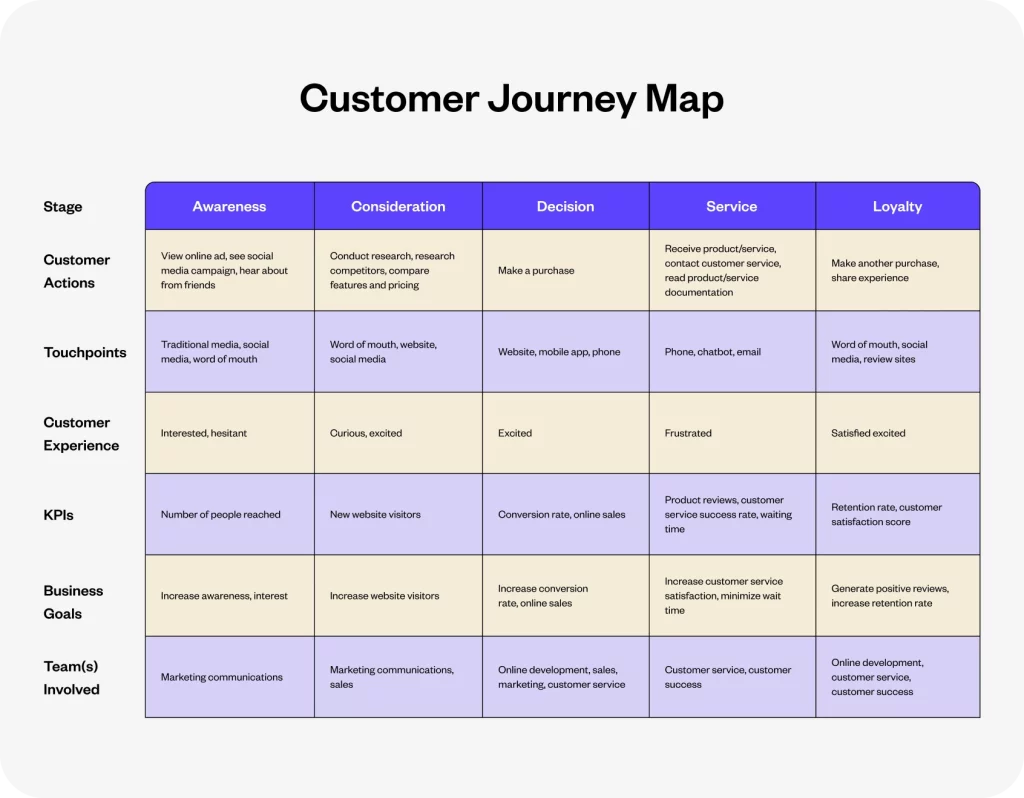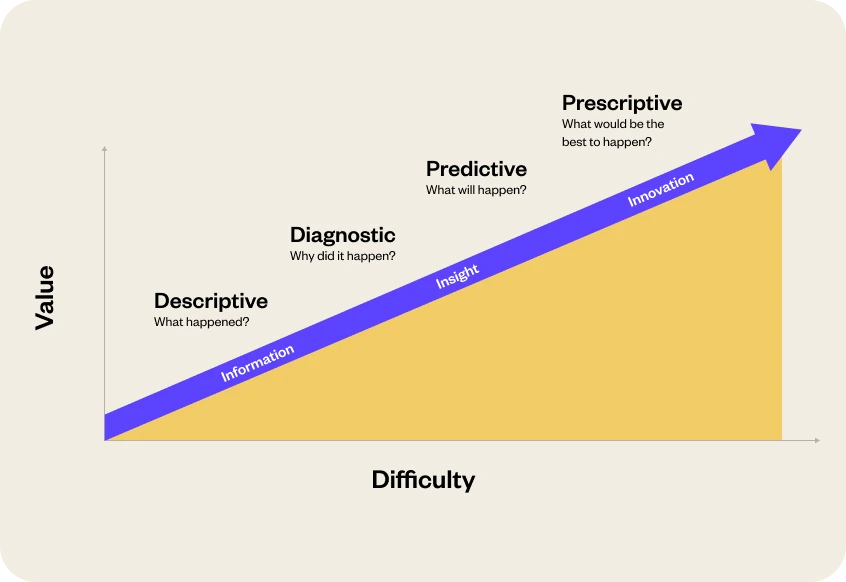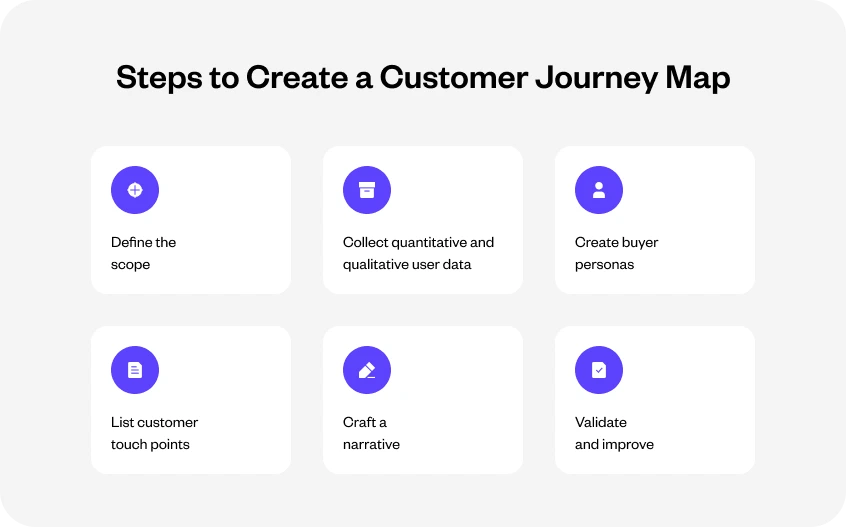Executive summary
The customer journey map has proved its efficacy as an essential tool to improve customer experiences and drive business growth. This blog explains everything about customer journey mapping. It offers a comprehensive guide on its creation and implementation. The blog also explores various aspects, such as the definition, stages, and types, as well as drafting effective customer journey maps. Read on to understand customer journey mapping benefits, including better customer experiences, personalized interactions, and heightened customer loyalty.
Introduction
Imagine navigating a labyrinth without a map; that’s the challenge businesses face without a clear understanding of their customer’s journey. As we step into the bustling commercial world of 2024, the concept of a ‘customer journey map’ transcends from a marketing jargon to an indispensable strategy. Steve Jobs, the visionary behind Apple, famously said, “Start with the customer experience and work back toward the technology, not the other way around.” It encapsulates why understanding and mapping the customer journey is crucial for any business aiming for success.
Customer journey mapping isn’t just about tracking sales; it’s about comprehending the myriad interactions and emotions customers experience with your brand. Did you know that in 2021, a staggering 70% of online shoppers abandoned their carts? This statistic underscores the unpredictable nature of customer behavior and the importance of mapping their journey. While we cannot predict every customer move, journey mapping equips businesses with insights into key milestones and pain points, enabling them to craft experiences that resonate deeply with their audience.
Related must-reads:
- Customer touchpoints – Mapping customer journey and improving CX
- How to personalize customer experiences at scale
- Customer experience vs customer service: More than just semantics
- AI and automation in customer experience
What is a customer journey map?
The customer journey map is an essential element in crafting customer-centric business strategies. Think of it as a detailed story that traces a customer’s journey with a brand, starting from their first encounter and weaving through various stages of interaction, culminating in a lasting relationship.
A customer journey map is more than just a visual tool. It is a comprehensive narrative that echoes the individual experiences and perceptions of a customer with a brand or product over time, spanning multiple channels. It goes deep into every interaction point, shedding light on the customer’s emotional journey, driving forces, and queries. This insightful map is a vital asset for businesses, helping them step into their customers’ shoes, grasp their needs and challenges, and refine the overall customer experience approach.
The beauty of a customer journey map lies in its specificity and relevance to your particular business context. It typically follows a timeline, charting the customer’s journey from their first interaction with your website to their progression toward a purchase and beyond. It includes key phases like onboarding, ongoing engagement, and even the process of cancellation or brand exit.
Businesses must deep dive into customer research to craft an authentic customer journey map. It’s not about guessing or using one-size-fits-all solutions. A genuine understanding of your target demographic is crucial. Understand their decision-making processes, influencers on their buying choices, and their anticipations at different stages of interaction with your brand. The insights gained from these inquiries are what shape a genuinely effective customer journey map.
A well-crafted customer journey map does more than just outline customer interactions; it brings to light areas where your business can improve and excel. By identifying moments of delight, friction, and potential drop-offs, you can strategically enhance your customer experience, ensuring that every step of the journey not only meets but exceeds customer expectations.
Related reads:
- What is customer experience management and its best practices?
- Customer experience in retail: Strategies and the future of CX
- Customer experience in banking: Importance, examples, and trends for 2024
- How to improve customer experience?
Customer journey stages: Navigating the path to purchase

The customer journey is a complex and multifaceted voyage, much like navigating through uncharted waters. To successfully guide customers from their first encounter to a lasting relationship, businesses need to understand the various stages of this journey. Each stage represents a unique set of opportunities and challenges, requiring specific strategies to engage and convert customers effectively.
Customer journey stage 1: Awareness
The journey begins with awareness. Here, customers first become aware of a need or problem but might not yet recognize the solution your business offers. This stage is about making that initial connection. Your goal is to educate and inform, not to sell. Content that works well in this stage includes educational articles, guides, or social media posts that address common problems or needs related to your product or service. This content should be accessible through various channels like blogs, social media, and search engines to maximize reach.
Customer journey stage 2: Consideration
As customers enter the consideration stage, they acknowledge their need for a product or service and evaluate available options. They are comparing, so your content must convey your offerings’ unique benefits and features. That is where detailed product guides, comparison charts, success stories, and case studies become crucial. These resources should be easily found on your website, through search engines, and social media platforms, helping guide potential customers in their decision-making process.
Customer journey stage 3: Decision
The decision stage is where the customer is ready to make a purchase. At this point, the focus shifts to facilitating a smooth transaction. Remove any barriers to purchase by offering precise and direct paths to buying your product or service, such as streamlined sign-up pages, transparent pricing information, and attractive promotions. This stage is about converting interest into action.
Customer journey stage 4: Retention/service
Post-purchase, the retention stage is critical to building a long-term relationship. Here, the focus is on providing an excellent onboarding experience and ongoing support to ensure the customer remains satisfied and engaged. Strategies include accessible customer service, knowledge bases for self-help, and regular communication through channels like email and social media.
Customer journey stage 5: Loyalty
The loyalty, or advocacy, stage is where satisfied customers become champions of your brand. This phase is about exceeding expectations and turning customers into advocates. Strategies to enhance loyalty include a user-friendly website, a robust product that delivers on its promises, referral programs, and perks for repeat customers. Delighted customers tend to share their positive experiences with others, expanding your brand’s reach.
Types of customer journey maps: Tailoring strategies to business goals
In the intricate tapestry of customer experience, various types of customer journey maps serve as vital tools, each offering unique perspectives and insights. Understanding these categories allows businesses to select the most appropriate variant to align with their specific goals and strategies. Here’s an overview of the different types of customer journey maps and how to leverage them for business success.
Type 1. Current state maps
These are the most commonly used customer journey maps. They provide a detailed view of what customers are currently experiencing while interacting with your brand. This type of map includes customers’ actions, thoughts, and emotional responses at each touchpoint. Current state maps are invaluable for identifying pain points and areas for improvement and ensuring the existing customer journey aligns with your company’s objectives.
Type 2. Day in the life maps
Unlike current state maps focusing solely on interactions with your brand, day-in-the-life maps offer a broader view of your customers’ daily lives, including activities and experiences outside of their interactions with your company. This holistic approach helps understand broader lifestyle patterns and pain points, offering insights into potential market opportunities or unmet needs. They are beneficial for companies looking to innovate or enter new markets.
Type 3. Future state maps
Future state maps envision the desired future interactions between customers and your company. These maps are based on current experiences but are geared towards a future vision, helping businesses plan strategic goals and the path to achieving them. They are instrumental in driving innovation, guiding product development, and shaping the future direction of customer experience strategies.
Type 4. Service blueprints
Service blueprints start with a basic customer journey map and layer additional details about the underlying factors that deliver the experience. These factors include people, policies, technologies, and processes. By showing the customer experience and the operational elements that support it, service blueprints are excellent for diagnosing problems in the current customer journey and identifying what is needed to achieve future state goals.
The customer journey mapping process: Crafting a blueprint for customer engagement
The process of customer journey mapping is a lot like assembling a puzzle, where every piece represents a crucial step in understanding and improving how customers interact with your business. This systematic approach helps companies to gain insights into customer experiences, identify challenges, and refine strategies for enhanced engagement. Let’s explore the step-by-step process of creating an effective customer journey map.
1. Identifying the buying process stages
The journey begins by defining the stages a customer moves through in their interaction with your brand. Typically, these stages include awareness, consideration, and decision. You can visualize the customer’s trail from initial awareness to the final purchase by mapping these stages horizontally. To outline these stages accurately, utilize data from various sources like CRM, analytics tools, and customer feedback.
2. Charting emotions and motivations
Each stage of the customer journey is imbued with emotions and motivations. Understanding these emotional states is crucial. Are your customers excited, anxious, or frustrated at different points? Mapping these emotions alongside the journey stages helps identify where you need to enhance the experience or alleviate pain points.
3. Detailing user actions
This element focuses on what actions customers take at each stage. For instance, in the awareness stage, they might be researching online, reading blogs, or following social media content. Tracking these actions provides insights into customer behaviors and preferences, enabling you to tailor your engagement strategies accordingly.
4. Conducting user research
Understanding where and how customers seek information is pivotal. During each stage of their journey, customers turn to various channels for research, be it search engines, social media, or customer reviews. Mapping out these research behaviors helps you identify where to focus your content and marketing efforts to be most effective.
5. Identifying and implementing solutions
The final step involves brainstorming and implementing solutions to improve the customer journey. This phase is about addressing identified pain points and enhancing positive experiences. It might include redesigning a website for better navigation, creating more targeted content, or improving customer support channels. The goal is to design a smoother, more enjoyable journey that increases customer satisfaction and loyalty.
6. Iterative review and adaptation
The customer journey map is not static. It’s a living blueprint that evolves as your customers and business grow. You must regularly review and update the map based on new data, changing market trends, and customer feedback. This routine process ensures your strategies remain relevant and effective.
How can customer journey maps improve customer experiences?
The utilization of customer journey maps emerges as a transformative strategy for enriching customer experiences. Below are the multifaceted ways in which customer journey maps can elevate the customer experience, making it a crucial component in the toolkit of any forward-thinking business.

1. Identifying and addressing pain points
Customer journey maps are instrumental in uncovering pain points in the customer experience. Businesses can pinpoint where customers face obstacles or frustrations by visualizing the customer’s journey. Whether it’s a complicated checkout process on a website or a slow response from customer service, locating these issues is the first step towards rectifying them and smoothing out the customer experience.
2. Empathizing with the customer
One of the primary benefits of a customer journey map is the empathy it enables towards customers. By walking in their shoes, businesses gain a deeper understanding of the emotions and challenges customers face at each stage of their journey. This empathetic approach is essential to create experiences that not only meet but anticipate customer needs, resulting in increased satisfaction and loyalty.
3. Streamlining customer interactions
With a comprehensive view of the customer journey, businesses can streamline interactions to enhance efficiency and satisfaction. For instance, if the map reveals that customers often seek help through social media, businesses can bolster their social media support, ensuring quick and effective resolution of queries.
4. Enhancing user interface and customer support
Journey maps enable businesses to critically scrutinize their digital interfaces and customer support mechanisms. Businesses can make informed improvements by understanding how and why customers navigate their websites or reach out for support. It could involve redesigning a web interface for better usability or training customer support teams to handle inquiries more effectively.
5. Developing a customer-centric culture
Central to the concept of customer journey maps is their ability to cultivate a culture that places customers at the forefront of an organization. When every department, from sales to support, aligns with the customer’s perspective, it leads to a cohesive approach to managing customer experiences. Regular discussions and analyses of the journey map can anchor customer experience objectives at the heart of organizational decision-making, ensuring actions and strategies consistently prioritize customer welfare.
Benefits of customer journey mapping
Integrating customer journey mapping into business strategies is more than a trend; it’s a transformative approach that brings many benefits. This part of the blog elucidates the diverse advantages of employing customer journey maps, each enhancing different facets of the customer experience and business operations.
1. Improved experience with product, service, or brand
Customer journey maps directly contribute to enhancing the overall experience with your product, service, or brand. By visualizing the customer’s journey, businesses can fine-tune each interaction, ensuring that every touchpoint is optimized for maximum satisfaction. This meticulous approach translates into a more enjoyable and fulfilling experience for the customer.
2. Personalization of experiences
Personalization is at the core of modern customer expectations. Journey maps enable businesses to understand customer preferences and behaviors at a granular level, allowing for tailored experiences. This personalization can manifest in customized product recommendations, individualized communication, and services that align with specific customer needs.
3. Consistency
Consistency across all customer interactions is vital for building trust and loyalty. Customer journey maps help businesses maintain a uniform standard of quality and service at every point of interaction, whether it’s in-person, online, or through customer support. This consistency reinforces brand reliability and professionalism.
4. Efficient problem resolution
By highlighting potential friction points, customer journey maps facilitate quicker and more effective problem-solving. Businesses can anticipate issues before they escalate and implement proactive solutions, leading to a more responsive and efficient customer service experience.
5. Relevant and timely communication
Understanding the customer’s journey helps in crafting communication strategies that are both relevant and timely. It can include targeted marketing messages during the consideration stage or supportive communication post-purchase, ensuring that customers receive the right information at the right time.
6. Enhanced product and service offerings
Insights from customer journey maps can guide product development and service improvements. By discerning customer needs and pain points, businesses can innovate and evolve their offerings to meet market demands better, ensuring they stay competitive and relevant.
7. Empowered decision-making
With a clear visualization of the customer’s journey, businesses can make informed, data-driven decisions. Whether it’s about marketing strategies, product development, or customer service enhancements, journey maps provide a factual basis for decision-making.
8. Increased trust and loyalty
Businesses can enhance their customer trust and loyalty by consistently meeting and exceeding customer expectations. Satisfied customers are more likely to return and make repeat purchases. Moreover, they also suggest the brand to others, which drives long-term business growth.
9. Co-creation of opportunities
Customer journey mapping often reveals new opportunities for collaboration and co-creation with customers. Engaging customers in the development process can lead to innovative ideas and solutions that resonate strongly with the target audience.
10. Continuous service/product improvement
Customer journey maps are dynamic tools that evolve with customer feedback and market changes. It allows for continuous improvement of products and services, ensuring that businesses adapt and grow in alignment with customer needs and preferences.
Steps for creating a customer journey map and best practices
Creating a customer journey map is about getting insights into your customer’s experiences and interactions with your brand. This process is crucial for businesses seeking to deepen their understanding of customer behavior and enhance their overall experience. Below is a step-by-step guide to creating a customer journey map and the best practices to ensure its effectiveness.

1. Define clear objectives
Begin by setting specific goals for your customer journey map. What do you want to achieve? Are you looking to improve customer satisfaction, increase sales, or reduce churn rates? Clearly defined objectives guide the mapping process and ensure the result aligns with your business strategies.
2. Conduct in-depth persona research
Understand your target persona deeply. Who are they? What are their needs, challenges, and behaviors? Utilize various data sources such as customer interviews, surveys, feedback forms, and analytics tools to gather both qualitative and quantitative insights. This step is crucial for ensuring that your map accurately reflects the experiences of real customers.
3. Identify key customer touchpoints
List all possible points of interaction that customers have with your brand, from the first website visit to post-purchase support. Touchpoints are crucial in understanding how customers interact with your brand and where they might face challenges.
4. Map the current state of the customer journey
Develop a visual representation of the current customer journey. This “as-is” map should include all identified touchpoints, highlighting customers’ actions, emotions, and experiences at each stage. Use a collaborative visual tool to ensure team input and align the map with the actual customer experience.
5. Analyze and identify gaps
Review the current state map to identify gaps, pain points, and areas of friction. Where do customers experience difficulties? What barriers prevent them from moving smoothly through the journey? This analysis is crucial for pinpointing areas for improvement.
6. Design the future state journey
Based on your findings, envision an ideal “future state” for your customer journey. It should address the identified gaps and optimize the overall experience. Consider innovative solutions and changes that could enhance the journey, making it more seamless and enjoyable for customers.
7. Implement changes and monitor results
Put your plan into action. Implement the mandatory changes and closely monitor their impact. Use customer feedback and data analytics to assess whether the adjustments are moving you closer to your objectives.
8. Iterate and evolve continuously
Never consider customer journey mapping as a one-time exercise. Regularly update your map based on ongoing customer feedback, market changes, and business growth. It ensures that your customer journey stays relevant and effective over time.
9. Foster cross-functional collaboration
Involve various departments in the mapping process. Sales, customer service, marketing, and product development teams can provide diverse perspectives, making the map more comprehensive and actionable.
10. Train your team on the customer journey
Educate your team about the customer journey map and its importance. It will help them understand their role in delivering a superior customer experience and encourage a customer-centric approach in their daily work.
5 Interesting real-world customer journey Map examples
Incorporating customer journey mapping into your business strategy is not just a theoretical exercise. It’s a practical approach that various leading brands have successfully implemented. Let’s explore some real-world examples to understand how diverse companies utilize customer journey maps to enhance customer experiences and drive business growth.
1. Spotify: Harmonizing music-sharing experience
Spotify, the renowned audio streaming service, leveraged a customer journey map to refine its music-sharing feature. The journey map detailed the user experience, from opening the app to engaging with shared music. Based on data research and customer surveys, this comprehensive mapping helped Spotify identify and smooth out user pain points, leading to an improved music-sharing process and elevated user satisfaction.
2. TurboTax: Streamlining tax preparation
TurboTax utilized a customer journey map to launch its new product, Personal Pro. The team combined data analysis, customer surveys, and expert insights to map the journey from website entry to tax filing completion. This exercise was pivotal in highlighting user challenges, allowing TurboTax to enhance user experience, and making tax preparation more intuitive and user-friendly.
3. Columbia Road: E-commerce strategy
Columbia Road, an e-commerce agency, created a customer journey map for a hypothetical online grocery store. This map outlined customer activities, goals, and experiences throughout the purchasing process, integrating KPIs and departmental responsibilities. This approach highlighted the customer’s path and aligned it with business metrics, ensuring each department contributed effectively to the overall customer experience.
4. Amazon: E-commerce customer experience
Amazon, one of the world’s largest e-commerce platforms, utilizes an intricate customer journey map. This map details each stage of the customer journey, from impressions to repeat purchases, with specific success metrics like conversion rates and ROAS. Amazon’s journey map is a testament to how detailed and metric-driven mapping can optimize the customer journey in e-commerce, enhancing customer engagement and satisfaction.
5. SaaS solutions like Hootsuite or MailChimp
In the B2B sector, particularly for SaaS products like Hootsuite or MailChimp, customer journey maps can be relatively straightforward. The journey, often taking place entirely digitally, can be mapped using tools like Excel. These maps typically include digital touchpoints such as social media for awareness, blog posts for research, and case studies or webinars for consideration. The simplicity of these maps reflects the direct and digital-centric nature of the customer journey in such industries.
How Yellow.ai can help level up your customer experience?
In an era where customer experience (CX) is a pivotal factor in business success, Yellow.ai stands out as a transformative tool for enhancing CX across various industries. Here’s how Yellow.ai can revolutionize your customer experience:
- 24/7 omnichannel support: Yellow.ai offers round-the-clock support across multiple channels, ensuring that your customers receive consistent and timely assistance, no matter where they are or what time it is.
- Personalization at scale: Utilizing advanced AI, Yellow.ai provides personalized interactions tailored to individual customer preferences and history, elevating the overall customer experience.
- Efficient customer service: The platform’s AI-driven chatbots handle routine inquiries efficiently, freeing up human agents to tackle more complex issues, thereby improving overall service quality.
- Dynamic voice AI: Yellow.ai’s voice AI capabilities enable natural and engaging voice interactions, making customer interactions more personal and less robotic.
- Data-driven insights: By analyzing customer interactions, Yellow.ai offers valuable insights into customer behavior and preferences, aiding in making informed decisions to enhance CX.
- Rapid deployment: With sector-specific templates, Yellow.ai ensures swift implementation, enabling businesses to upgrade their customer support without significant downtime.
- Enhancing human agent efficiency: The platform aids human agents with AI-generated insights, improving resolution times and customer satisfaction.
- Continuous improvement: Yellow.ai’s analytics provide ongoing feedback on performance, helping businesses continually refine their customer service strategies.
See the difference in your CX with next-gen AI-powered automation

The final word on customer journey mapping
The customer journey map is a blueprint and reflection of your business’s commitment to understanding and serving your customers at every touchpoint. In crafting your customer journey map, remember that it’s a living document evolving with your customers and your business. It’s an ongoing process of learning, adapting, and improving. By embracing this tool, you are charting a path for your customers and setting a course for your business toward greater understanding, engagement, and success.
Frequently asked questions (FAQs)
What is customer sentiment analysis?
Customer sentiment analysis is about evaluating and interpreting customers’ reactions, emotions, and opinions about a product, service, or brand. The process of customer sentiment analysis involves analyzing customer feedback and conversations using technology like AI and NLP. It provides insights into how customers feel about their interactions with a business.
How can sentiment analysis be used to improve customer experience?
Sentiment analysis helps businesses understand customers’ emotional responses, enabling them to tailor experiences, address concerns proactively, and make data-driven decisions to enhance customer satisfaction and loyalty.
What kind of data can an institution gather from sentiment analysis to improve customer experience?
Sentiment analysis yields data on customer preferences, pain points, satisfaction levels, and emotional responses to products or services. This information is vital for refining customer strategies and improving overall experience.
Which customer sentiment metric is the strongest predictor of future purchase behavior?
Net Promoter Score (NPS) is often considered a strong predictor of future purchase behavior. It examines the likelihood of customers recommending a brand to others, reflecting their overall satisfaction and loyalty.
Why is it important to measure customer sentiment?
Measuring customer sentiment is essential as it gives insights into how customers perceive a brand. This understanding helps businesses enhance product offerings, improve customer service, and foster positive relationships, leading to increased customer loyalty and business growth.
What is the sentiment score in the customer journey map?
The sentiment score in a customer journey map quantifies customers’ emotional responses at different journey stages. It helps businesses identify areas of delight or dissatisfaction, guiding improvements in customer experience and engagement strategies.






















